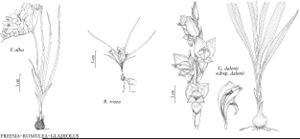Difference between revisions of "Freesia alba"
Gard. Chron., ser. 3, 19: 392. 1896.
FNA>Volume Importer |
imported>Volume Importer |
||
| (3 intermediate revisions by 2 users not shown) | |||
| Line 6: | Line 6: | ||
|place=3, 19: 392. 1896 | |place=3, 19: 392. 1896 | ||
|year=1896 | |year=1896 | ||
| + | }} | ||
| + | |special_status={{Treatment/ID/Special_status | ||
| + | |code=I | ||
| + | |label=Introduced | ||
| + | }}{{Treatment/ID/Special_status | ||
| + | |code=F | ||
| + | |label=Illustrated | ||
}} | }} | ||
|basionyms={{Treatment/ID/Basionym | |basionyms={{Treatment/ID/Basionym | ||
|name=Freesia refracta var. alba | |name=Freesia refracta var. alba | ||
|authority=G. L. Meyer | |authority=G. L. Meyer | ||
| + | |rank=variety | ||
|publication_title=Z. Schweiz. Gartenbauver. | |publication_title=Z. Schweiz. Gartenbauver. | ||
|publication_place=1: 37, plate 3. 1881 | |publication_place=1: 37, plate 3. 1881 | ||
| Line 28: | Line 36: | ||
|elevation=50 m | |elevation=50 m | ||
|distribution=Calif.;South Africa. | |distribution=Calif.;South Africa. | ||
| + | |introduced=true | ||
|discussion=<p><i>Freesia alba</i> often has been confused with F. refracta in older literature, and consequently the latter has been erroneously listed in regional floras in North America. <i>Freesia</i> refracta is rarely cultivated; <i>F. alba</i> and cultivars derived from crosses between it and other species are widely grown, as both ornamentals and cut flowers.</p> | |discussion=<p><i>Freesia alba</i> often has been confused with F. refracta in older literature, and consequently the latter has been erroneously listed in regional floras in North America. <i>Freesia</i> refracta is rarely cultivated; <i>F. alba</i> and cultivars derived from crosses between it and other species are widely grown, as both ornamentals and cut flowers.</p> | ||
|tables= | |tables= | ||
| Line 37: | Line 46: | ||
-->{{#Taxon: | -->{{#Taxon: | ||
name=Freesia alba | name=Freesia alba | ||
| − | |||
|authority=(G. L. Meyer) Gumbleton | |authority=(G. L. Meyer) Gumbleton | ||
|rank=species | |rank=species | ||
| Line 52: | Line 60: | ||
|publication title=Gard. Chron., ser. | |publication title=Gard. Chron., ser. | ||
|publication year=1896 | |publication year=1896 | ||
| − | |special status= | + | |special status=Introduced;Illustrated |
| − | |source xml=https:// | + | |source xml=https://bitbucket.org/aafc-mbb/fna-data-curation/src/2e0870ddd59836b60bcf96646a41e87ea5a5943a/coarse_grained_fna_xml/V26/V26_835.xml |
|genus=Freesia | |genus=Freesia | ||
|species=Freesia alba | |species=Freesia alba | ||
Latest revision as of 21:17, 5 November 2020
Plants (5–)12–40 cm. Stems erect, simple or branched, minutely pubescent. Leaves (4–)6–8, erect or inclined; blades slightly shorter than to ± equaling spike. Spikes horizontal, (2–)4–6(–8)-flowered; spathes 5–8 mm, outer usually longer than inner, firm-textured. Flower strongly scented, funnel-shaped; perianth tube very gradually flared, distal portion (15–)20–40 mm, basal portion slender, 6–12 mm; tepals spreading, white, often with yellow markings on lower tepals, tepals and tube flushed with purple abaxially, oblong, 15–18; filaments included, 15–25 mm; anthers 6–9 mm, unilateral, sometimes parallel; ovary 2–3 mm; style branching opposite anther apices. Capsules ca. 10 mm, lightly papillose. Seeds ca. 2 mm diam.
Phenology: Flowering mainly Mar.
Habitat: Roadsides, abandoned gardens, grassy slopes
Elevation: 50 m
Distribution
Introduced; Calif., South Africa.
Discussion
Freesia alba often has been confused with F. refracta in older literature, and consequently the latter has been erroneously listed in regional floras in North America. Freesia refracta is rarely cultivated; F. alba and cultivars derived from crosses between it and other species are widely grown, as both ornamentals and cut flowers.
Selected References
None.
